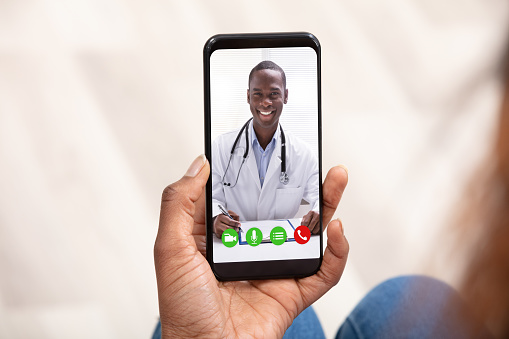
You don't have only Netflix to thank technology for. Technology is bringing your doctor right into your bedroom – actually virtually. This is what telehealth is all about!
Fundamentally, telehealth leverages two-way telecommunication technologies, allowing you to receive premium and effective medical care remotely.
Sounds like an epic Steven Spielberg sci-fi movie?
No, these technologies include everyday devices like your smartphones and computers, allowing you to virtually collaborate with your health care provider, transferring accurate data in real-time.
Telehealth is also referred to as telemedicine, connected care, or virtual care. They all refer to health care executed over digital systems as opposed to conventional in-person health care.
Ready for a story? Let us tell you how telehealth all began.
The History of Telemedicine
Dr. Kenneth D. Bird, a pulmonary specialist and internist, is renowned as the father of modern telemedicine. Sometime in 1968, Bird proposed a system of investigating patients leveraging two-way, interactive television.
In the first telemedicine model, Dr. Bird connected a medical station situated at Boston's Logan Airport with the hospital's doctors responsible for supplying remote healthcare procedures like diagnosis, treatment, and image transmission.
Despite the initial enthusiasm that greeted Dr. Bird's heroics, by the 1970s, telemedicine has receded from the mainstream, almost being abandoned.
Fast forward to this era, there has been an enormous resurgence in telemedicine. A lot of that resurgence is not unconnected to the profusion in today's digital technologies.
Statistics have been encouraging so far. According to the American Telemedicine Association, over one-half of U.S. hospitals today have a telehealth program.
What more, the American Medical Association and Wellness Council of America reports that almost 75% of all urgent care, E.R., and doctor visits can be effectively executed over video or phone, making such visits unnecessary.
All these say one thing: telehealth has come to stay!
Challenges of Telehealth So far
For a practice born in 1968, we should have had far more penetration of the American healthcare system from telemedicine, right?
For context, Intel was born in 1968, and today it is worth $240 billion. This begs the question: what is keeping telemedicine back?
Several factors are restraining the adoption of telemedicine today. First, there are still technological barriers associated with broadband.
Feel free to be embarrassed that 34 million Americans do not have adequate broadband internet access, with about 40% of that number situated in rural interiors.
Therefore, there is a significant digital divide between urban America and these rural areas. Effective telemedicine requires a reasonable bandwidth for top-notch video quality and image resolution.
But we will be wrong to heap all the blame on technology. Regulations have not helped matters. In the early days of the American Telemedicine Association (ATA), licensing wasn't a major problem.
This was because the majority of telemedicine systems ran their operation from one state. This is a huge deviation from what we have today, where we have multistate systems operating multistate practices.
Licensing is becoming more challenging with the migration of major healthcare providers into a national system. But the problems exceed just licensing.
Telemedicine adoption has been constrained by practice regulations where many state medical boards declare patients must physically meet the physician before any telemedicine service is initiated.
Telemedicine and COVID
With hospitals being stretched by the pandemic, the American health care system was awakened to the urgent need for alternatives to in-person consultations.
Patients needed to take their medications, get optimal care while trying to physically steer clear of the hospital premises. Indeed, telemedicine filled this void appreciably.
Dr. Maggie Cadet, a rheumatologist and the associate attendant at NYU Langone medical cente, couldn't be any less thankful for telemedicine during the pandemic.
With 26,800 COVID-related deaths in New York as of December 1, with over 65% being recorded in New York City, it was a no-brainer that New York had to be shut down.
To say Dr. Maggie Cadet was perturbed about her patients was putting it mildly. A lot of these patients were on immune-suppressing medication, the most needing these medications to be monitored, analyzing symptoms for disease flares and possible side effects.
Telemedicine was a darling relief for Dr. Maggie. By simply connecting remotely with her patients, Dr. Maggie could sustainably stay in touch with their patients without them having to sacrifice their convenience or safety for in-hospital visits.
According to Dr. Maggie Cadet, "And a lot of my patients who have lupus or rheumatoid arthritis or Sjogren's syndrome really needed to get access to this medication. And so by having the opportunity to do telehealth not only was I able to keep connected with all of my patients in terms of monitoring their symptoms."
How Well is Society Adopting Telemedicine?
Of course, telemedicine is not TikTok, so it wasn't going viral that easily. As of today, telemedicine is steadily diffusing through the American healthcare infrastructure. The pandemic, as said, has triggered increased adoption of telehealth.
According to a survey by the CDC (Center for Disease Control and Prevention), the use of telehealth services increased during the early months of the pandemic.
Data from the four biggest U.S. telehealth providers, whose services were accessible in all states, revealed that within January-March 2020, telehealth use increased by 50% compared to this very period in 2019.
Would telemedicine be thoroughly replacing traditional medicine (with in-person leap)? No, that would be an exaggerated leap – at least for now. There needs to be synergy between in-person health care and telemedicine.
Patients with more chronic conditions like abdominal pain, chronic cough, or even acute joint swelling and fever need to come in to be analyzed physically before they go back to telemedicine.
How are physicians and patients adapting?
Healthcare practitioners are steadily improving in their proficiency with telehealth technology systems. This is a significant shift from the orthodox in-person consultation the majority of these physicians were used to.
According to Dr. Maggie Cadet, "we are used to seeing patients in person. Sometimes it is easier just to see a patient touch a patient; this is our rhythm. So it did take me personally some time to get comfortable and utilize the technology."
The same applies to Dr. Olanma Okoji, a gastroenterologist with Capital Digestive Care. Speaking on her familiarizing with telehealth technology, she says:
"At first, I too, was nervous because it's like, 'I don't know how this is going to work.' But as I learned the technology more, I'm able to assist my patients.
I'm able to tell them, well, if you open up Google Chrome, and then you do this on your phone and you press this link, we'll definitely do."
On the part of the patients, there is an increased need for sensitization so they become more comfortable with remote medical consultancy. There is a conservatively inspired inertia, especially on the part of seniors, to pivot to telemedicine.
A lot of this reluctance to adopt telemedicine has to do with stereotypes that in-person sessions with physicians were more effective.
White-haired grandpa and grandma are understandably unconvinced that they could consult their doctors digitally over, say, FaceTime on phone or Zoom sessions on their computers, and get impressive results.
According to Dr. Sabrina Smith, the executive director Center of Applied Research in Telehealth "I think that that telehealth literacy and community preparedness are key in enhancing the implementation of telehealth. I think that there's a lot that we can do to facilitate and expedite this so that when an individual is actually going to have a telehealth encounter, they are prepared and prepared in a variety of ways."
You will agree this establishes the need for telemedicine to be more "domesticated" in terms of training and enlightening patients on how to use these technologies.
This calls for combined action from private and public stakeholders to accelerate telemedicine's adoption, tapping into the voluminous promise it boasts for contemporary medical care.









